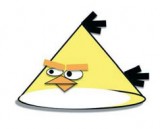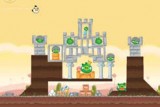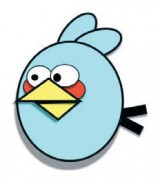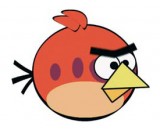Angry Birds mean happy children and the chance to hatch some golden learning opportunities, says VITAL’s Steve Bunce...
“You’ve got to pull the bird back and smash it into those pigs,” she said. “Why?” I asked. “Because they stole the birds’ eggs!” I watched as my daughter continued to fire red, blue and yellow birds into a building, destroying it as she went and bashing green pigs on the head. She was playing Angry Birds: a worldwide sensation that’s currently top of the mobile phone game charts. So, I tried it too; then tried again, and again. It was not only really engaging but I found myself experimenting with different strategies, refining them and persevering until I achieved success. In addition, there were many differentiated levels to play, helping me to develop and improve my skills. What a great learning opportunity!
 Angry Birds has had great success on smart mobile phones. It is a simple puzzle game where the player uses a catapult or slingshot to fire the birds into structures made of brick, wood or stone. The aim is to squash the naughty green pigs who have stolen the birds’ eggs. Each bird has a unique property. You can now even buy plush toys of the birds and an animated movie is planned for the near future.
Angry Birds has had great success on smart mobile phones. It is a simple puzzle game where the player uses a catapult or slingshot to fire the birds into structures made of brick, wood or stone. The aim is to squash the naughty green pigs who have stolen the birds’ eggs. Each bird has a unique property. You can now even buy plush toys of the birds and an animated movie is planned for the near future.
Currently, I work for VITAL, a national programme sponsored by the Department for Education and run by the Open University, which supports the use of innovative technologies. VITAL provides professional development for schools and teachers using technology (vital.ac.uk). There are courses and research groups to introduce the concept of gaming into the classroom.
We used the game with Y1 pupils, working individually and in pairs on an iPad. Recently, Angry Birds has been released to play on the computer, so more pupils can access it at school and at home. You need to install the free Google Chrome web browser in order to play it (chrome.angrybirds.com).
When you ask the pupils how they have answered a maths problem, they try and explain the process and use the correct terms. This can be the same with Angry Birds. Children can explain how they chose the angle to fire the bird, the properties of the bird and how they can use them and the properties of the materials in the structure. I found it was great to ask the pupils their predictions and strategies for each level and how they were going to attempt it. Working in pairs, the pupils told each other how they would approach each challenge, so we were able to hear their thoughts while playing. They were engaged, making decisions, communicating and they kept going until they solved the level.
 Each level has a three star rating system, and players are awarded more stars depending on how efficiently they complete the problem. The next level is then unlocked. This provides instant feedback on performance. Most pupils, if they did not achieve three stars, would continue to the next level and return later to the level to improve their score. Some would persist with the level until they got the top score before proceeding.
Each level has a three star rating system, and players are awarded more stars depending on how efficiently they complete the problem. The next level is then unlocked. This provides instant feedback on performance. Most pupils, if they did not achieve three stars, would continue to the next level and return later to the level to improve their score. Some would persist with the level until they got the top score before proceeding.
 There are many activities that can be linked to the Angry Birds theme. For example:
There are many activities that can be linked to the Angry Birds theme. For example:
• Instructional writing – the pupils can write instructions on how to complete a level in a numbered list of actions. They could record their voices, so that a player could listen to it while playing.
• An Angry Birds presentation can be created using software such as Powerpoint, including screen shots from the game. Images from the iPhone or iPad game can be captured by pressing the lock and home buttons at the same time. The children can then annotate their walk-through with labels. A whole class guide could be made where each group contributes one walk-through.
• The game has a very short video as a simple story start, showing the birds looking at an empty nest and the green pigs disappearing with their eggs. This could be a stimulus for the children to write the introductory chapter and continue the story of how the birds got their eggs back. Also, from the web version there is a link to a cinematic trailer for the story (youtube.com/watch?v=1Bk_nqUQ0fc). The children could describe the characters, the setting and create the storyboard for a new movie.
 • Bird names and bird terms, such as preening, could be collected and displayed as a word cloud in a bird shape using Tagxedo (http://www.tagxedo.com)
• Bird names and bird terms, such as preening, could be collected and displayed as a word cloud in a bird shape using Tagxedo (http://www.tagxedo.com)
• A fantastic stimulus for collaborative writing is Storybird (storybird.com) where you can create beautiful stories of your own using art donated by professional illustrators. Selecting pictures and adding words, the children can create an online book telling their bird story.
• Most drawing and presentation programs can create simple geometric shapes. So, why not challenge the class to create images of the birds using only circles, ovals, rectangles and triangles?
Keeping with the bird theme, Aviary is a free suite of creative online tools (aviary.com/tools). The tools in the suite are named after birds; for example, Phoenix is an image editor that can be used to create an Angry Bird (aviary.com/tools/image-editor).
Phoenix is an online editor, however, when complete, images can be downloaded to your computer.
Sound is a major feature of games. Angry Birds has a very catchy and recognisable theme tune and the birds make distinctive noises. The Aviary suite has a sound editor called Myna (aviary.com/tools/audio-editor), so the children could record their stories or create new birdsong for each bird. Another great tool is the sound loops software called Roc (aviary.com/tools/music-creator), so children could make a new Angry Birds theme tune!
 Using the birds theme, we can think of many ways to use ict across the curriculum. for example:
Using the birds theme, we can think of many ways to use ict across the curriculum. for example:
ENGLISH – write a news report from outside the nest – the scene of the crime. Create an advert for a younger audience using animation software Zu3D (zu3d.com) or Anithings (anithings.com).
MATHS –measure the angles at which the birds take off. Analyse the scoring system using algebra, e.g. ‘3 glass blocks and 2 wooden blocks equals a score of ?’. Calculate the speed of birds.
SCIENCE – how are the birds adapted for their environment? Can you design a new bird for a different habitat (also see the RSPB game ‘Avian resurrection’ (rspb.org.uk/youth/play/avianresurrection.aspx).
DATALOGGING – how can a bird insulate its nest to keep warm?
GEOGRAPHY – follow a bird’s migration route using Google maps.
HISTORY – the extinction of the Dodo. Where and why did it happen? Which birds are endangered today?
PE – throwing bean bags into buckets or throwing cricket balls in an arc.
RE –Where did the birds come from? Examine creation stories from different religions and Ted Hughes’ How the whale became.
TECHNOLOGY – build a catapult. There is a great example from an American school of enquirybased learning using catapults (ilearntechnology.com/?p=3970)
VITAL is all about supporting teachers and schools to develop their use of ICT professionally. If you have a particular request, please do get in touch via the website http://www.vital.ac.uk
Make every lesson an experiment
Cross Curricular
